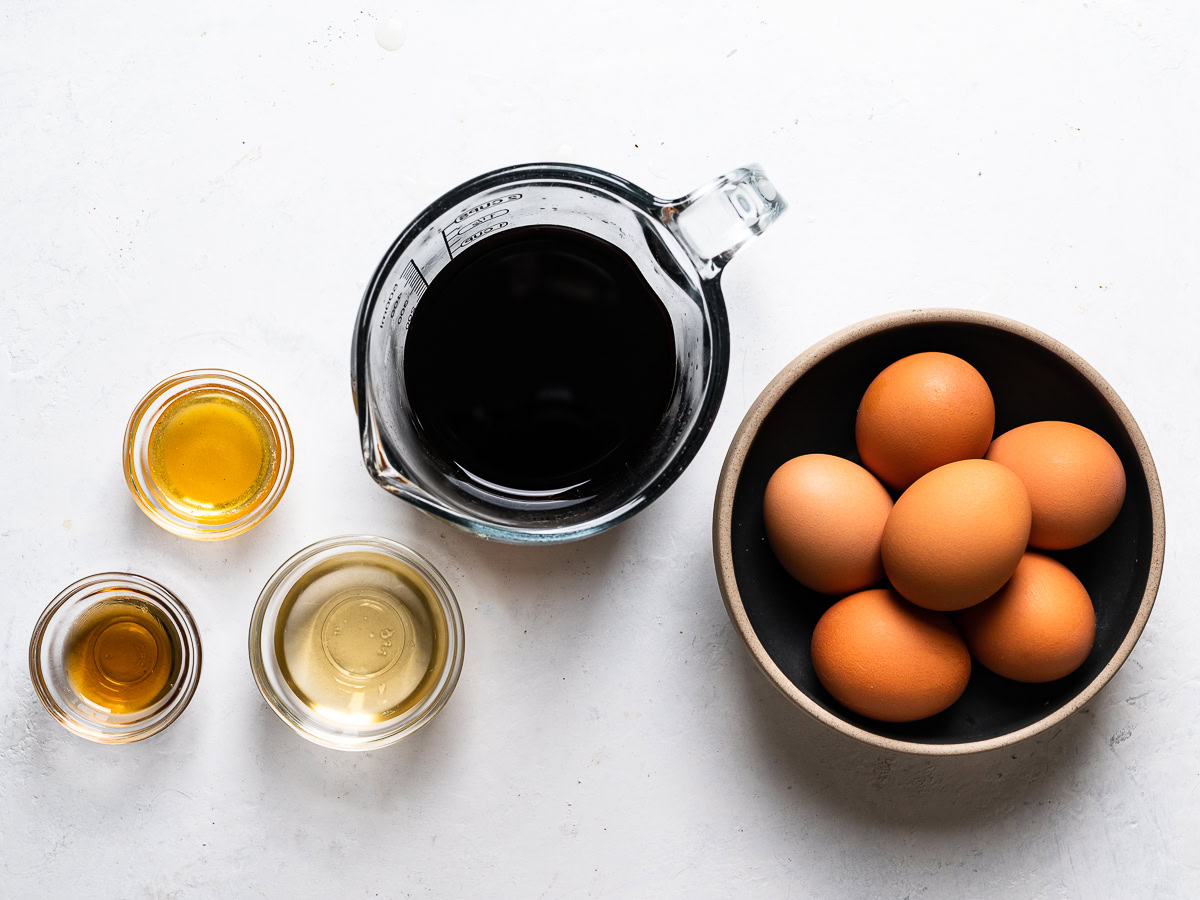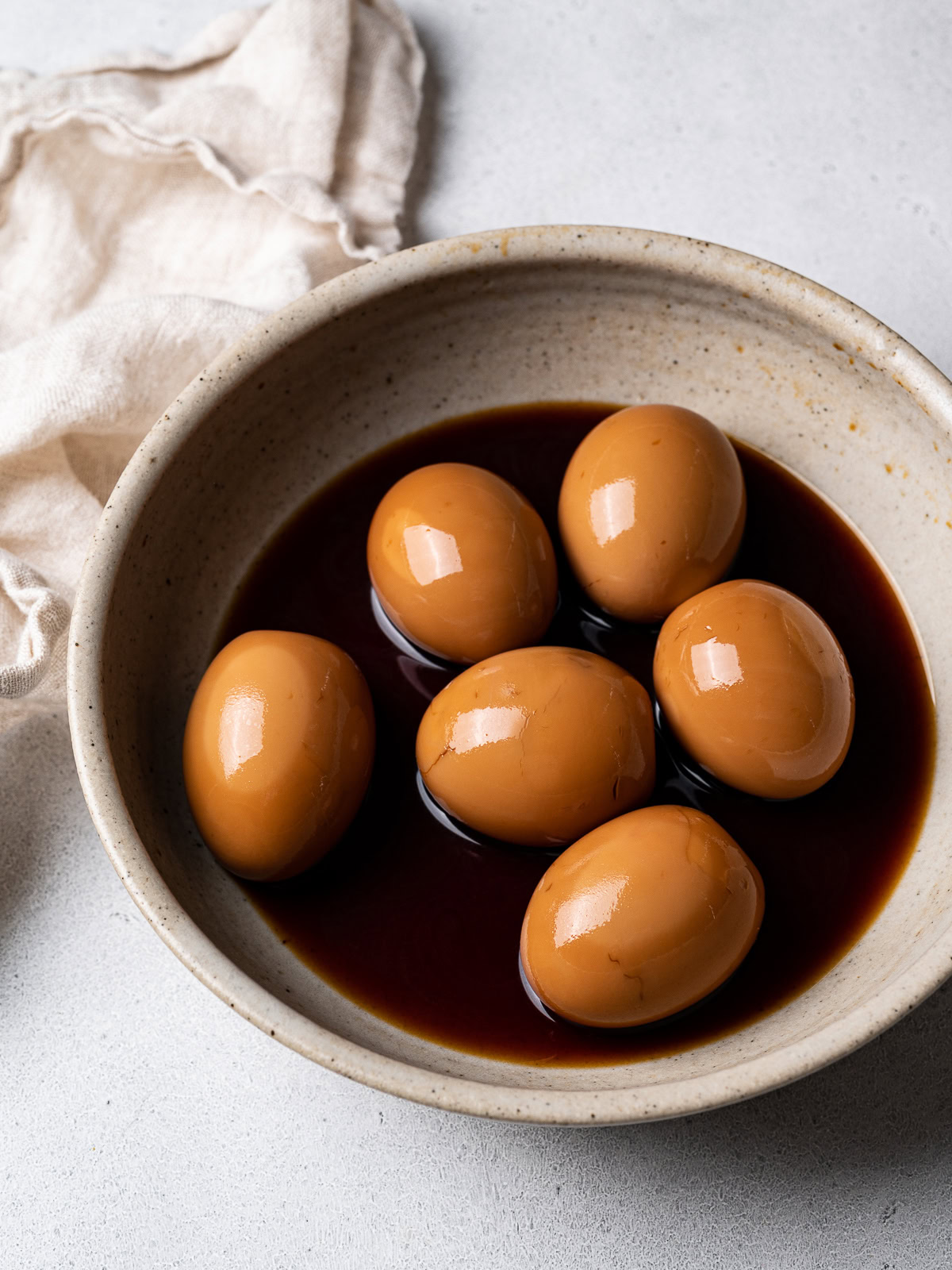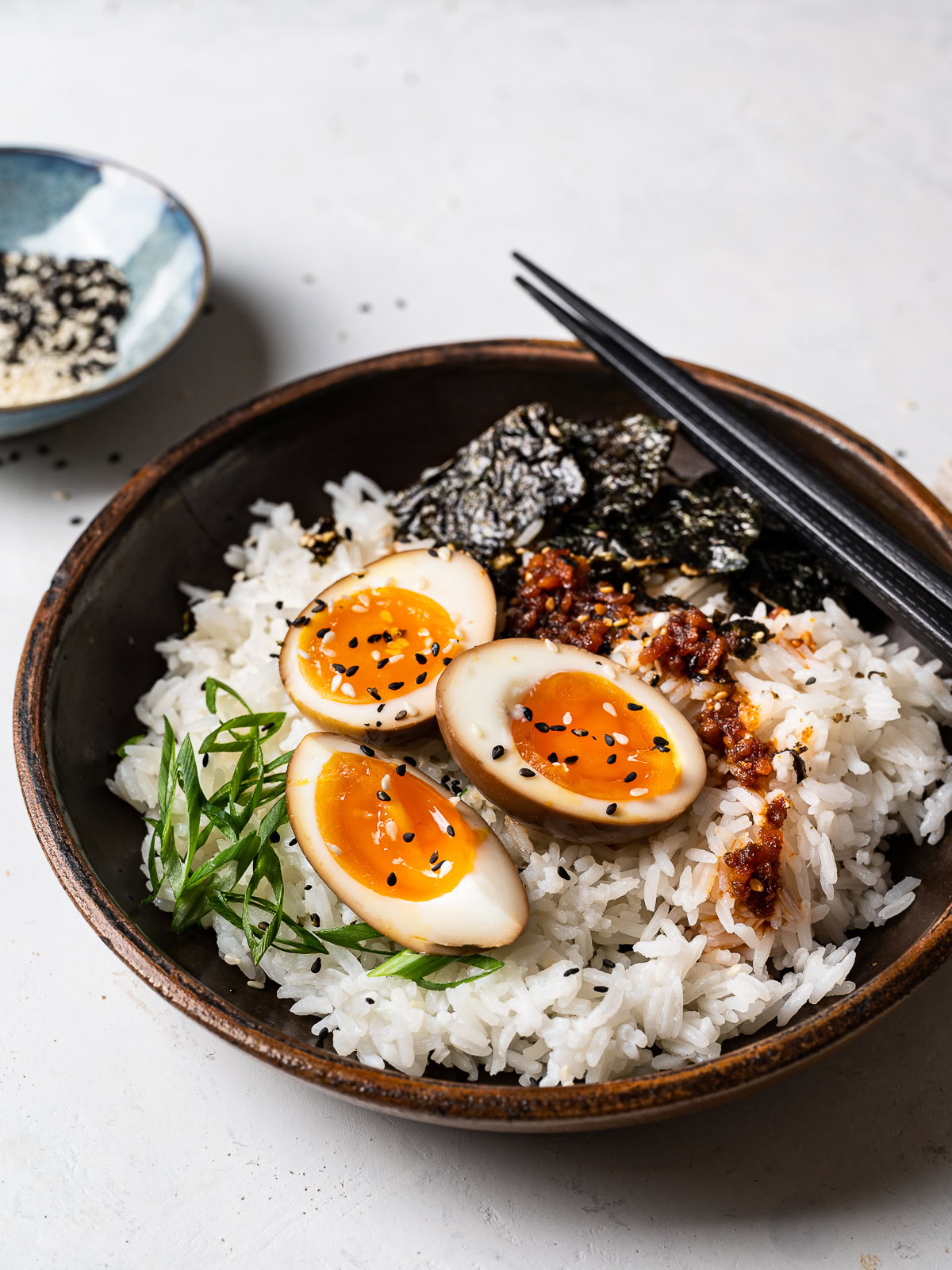Full of sweet, salty, savoury funkiness, the flavour of these jammy Soy Sauce Eggs, also known as ramen eggs, will absolutely delight you! Enjoy them over noodles, sticky rice, or just on their own as a heavenly snack.

Peek into my fridge and nine times out of ten you will find a bowl of pre-cooked, hard-boiled eggs waiting to be eaten. They serve as my go-to for a running-out-the-door speedy breakfast, for lunches, for snacking, or as a side for a quick light dinner.
Soft-boiled eggs did not appeal to me as much until I tried the ones that top a ramen bowl. Umami-packed with a sweet, salty soy brine, these jammy eggs were revelatory and they are the ones I now regularly crave.
If you love eggs and savoury things as much as I do, you simply must give this recipe a try. Though you need a little patience to wait for them to soak up the marinade, the preparation couldn’t be easier, or quicker, and they are so worth the wait.
What Are Soy Sauce Eggs?
If you enjoy eating ramen, you’ve likely had Shoyu Tamago also known as Japanese soy sauce eggs or ramen eggs. These eggs have been soft-boiled so the center remains jammy, then they are marinated in a dark soy sauce mixture for a few hours or overnight.
While the peeled eggs marinate, they soak up the salty-sweet soy-based sauce and the exterior turns a medium to dark brown colour. Though the exterior of the egg will taste deliciously salty, the marinade does not quite seep into the interior which makes the saltiness very tolerable.
Aside from being famously delicious on top of a ramen bowl, soy sauce eggs are also fabulous as a quick snack or served over a bowl of noodles or steamed rice.
Soy sauce eggs can easily be made at home. The marinade recipe I am sharing with you today, I created with guidance via Food52, and Bon Appétit. To me, it is a marinade that has the perfect balance of flavour and is super easy to whip together. Feel free to add more spices such as red chili flakes, sliced garlic, and/or ginger.
In this post you will also find all my tips to get the perfect jammy eggs, plus tips on how to easily peel eggs.

How To Perfectly Boil Soft Eggs
I love hard-boiled and soft-boiled eggs so much, I guarantee you I have tried just about every hack there is for a non-cracking, perfectly cooked, easy-to-peel egg. But given there are so many variables that can affect the outcome—the pot you use, the age, brand, and size of the eggs, etc—there doesn’t seem to be an absolute foolproof method. That said, I have some tips for you that almost always work for me.
Note that even though this recipe focuses on soft-boiled eggs, except for cooking time, these cooking tips work for hard-boiled eggs as well.
Bring the water to a boil before adding the eggs. Some recipes will tell you to add the eggs then bring the water to a boil. The problem with this method is that depending on the pot you use, or the amount of water you use, the water may take less or more time to cook. This means the eggs will be sitting, and slowly cooking, in warm water for a little while before the boiling starts which makes it harder to perfectly gage the overall cooking time for the eggs.
Don’t use fridge-cold eggs. Because we are adding the eggs to boiling water, the temperature change can cause the eggs to crack. Let the eggs sit on the counter 30 minutes before you boil them. Alternatively, you can place fridge-cold eggs in slightly hot water for 3-4 minutes.
Reduce to a simmer before adding the eggs. Room-temperature eggs shouldn’t crack when carefully placed in boiling water. But for extra insurance, I like to lower the boiling water to a simmer right before I add the eggs. Once all the eggs are in the pot, immediately bring back to a gentle boil (100ºC).
For soft-boiled eggs, swirl the water and eggs in a circular motion. This helps keep the soft yolks in the center of the egg. I can’t say if this hack is absolutely necessary but it seems to work for me so I’m not skipping it. Use a chopstick or wooden spoon to swirl the water and eggs in a circular motion for the first minute or so that the eggs are boiling.
Set a timer! Particularly for a soft-boiled egg, even 30 seconds will make a drastic difference on the outcome. The second all the eggs are in the water, set a timer to the desired time. The total cooking time will depend on your preference.
Boil for 6 minutes and 30 seconds. It seems almost ridiculous to give a time with precise seconds. But for soft-boiled eggs, mere seconds will make a difference. Soy sauce eggs are the only eggs I enjoy a little jammy and I find that 6 minutes and 30 seconds is perfect for me. This time frame only works if you follow my recipe to a T. Meaning your eggs are room temperature and you start with boiling water. If you prefer them less jammy, go a full 7 minutes, or 7 minutes and 15 seconds. For even jammier yolks, 6 minutes exactly will work. Note that jammy eggs will “cure” a little more when marinated overnight which I find very appealing.
Immediately place the eggs in an ice-water bath. While the eggs are boiling, prepare a bowl with cold water and ice. As soon as the timer beeps, transfer the eggs to the ice-water to stop them from cooking. Let sit in the ice-water for at least 8-10 minutes. If you don’t have ice available, make sure the water is really cold, and change it out after 2 minutes (dump the the now warm-ish water and add more cold).

Hacks That Make Peeling Eggs Easier
Few things are more frustrating than losing chunks of egg white when you’re peeling an egg. The cooking method tips mentioned above are already going to help make the eggs peel easier. However, here’s a few more hacks that I have found really work for me.
- Use older eggs. The fresher the eggs, the harder they are to peel. Try and use eggs that you know are at least a week old.
- Add vinegar and salt to the boiling water. A splash of vinegar and a pinch of salt apparently help soften the eggshell which makes it easier to peel. The difference is subtle but I do notice a difference and I’ll take all the help I can get to make peeling eggs easier.
- Use a small spoon to gently crack the bottom, wider end of the egg first. At the wider end of the egg, there is a bit of a gap between the eggshell and membrane. This gap makes it easier to to start removing the membrane and the shell.
- Gently crack the egg all over. Once you crack the wider end of the egg, use the spoon to gently crack the rest of the egg all over. For presentation sake, soy sauce eggs should be nice and smooth so make sure not to crack the shell too aggressively.
- Place the egg under running water while peeling. If your eggs are still being difficult to peel, try peeling them under a gentle stream of water.
I’m sure there are many more tips and hacks out there so if you know any that weren’t mentioned here, do share! We’d love to hear from you!
Ingredients And Notes
You only need 5 ingredients to make these soy sauce eggs (excluding water). Best of all, this soy sauce marinade comes together fast without the need for simmering on the stovetop.

- Eggs – You will need 6 large eggs for this recipe. For this recipe, it is important the eggs are room temperature before they are boiled. Leave them on the counter for at least 30 minutes before you plan on using them.
- Low-sodium soy sauce – You will need almost a cup of soy sauce so make sure you have plenty. Given that this is a predominant ingredient in the marinade, try and use a traditionally brewed soy sauce (few ingredients) for best results.
- Honey – Just a tablespoon of sweetener is needed to balance all the saltiness. You can use regular white sugar or any other sweetener of your choice. If using a granular sugar just make sure to mix it with the warm water first until it is completely dissolved. If you happen to have Mirin, a staple in Japanese cuisine, you can use a 1/4 cup in place of the honey. Mirin is similar to sake but it is a little sweeter and contains less alcohol. If serving the eggs to young children, you may want to boil the soy sauce mixture for a minute or so to allow the alcohol to evaporate.
- Rice vinegar – For more briny flavour but also helps preserve the eggs a little longer.
- Sesame oil – Optional, but I love the nutty flavour in the sauce.
- Water – Some recipes like to add a lot of water in order to fully cover the eggs but I find too much water dilutes the marinade. If you turn the eggs half-way through the marinade time, they will be sufficiently coated in the soy-brine all over.
How To Make Soy Sauce Eggs
- Make the marinade. In a medium bowl, combine soy sauce, sesame oil, honey, vinegar, and water.
- Boil the eggs. Bring a medium saucepan of water to a boil. Lower to a simmer and carefully add the eggs (a skimmer makes this easier). Turn the heat to medium high (it should be gently boiling again) and immediately set a timer for 6 minutes and 30 seconds. Use a wooden spoon or chopstick to swirl the water and eggs in a circular motion for the first minute or two that the eggs are boiling.
- Prepare the ice bath. While the eggs are boiling fill a large bowl with cold water and ice. When the timer goes off, use a slotted spoon (or skimmer) to transfer the eggs to the prepared ice bath. Let the eggs cool for 7-10 minutes, then use a small spoon to gently crack the egg all over. (See all my tips above on how to peel an egg). Peel all the eggs, occasionally dipping them back in the ice water to make the peeling easier.
- Marinate the eggs. Place peeled eggs in the soy sauce marinade, then cover and refrigerate for at least 2 hours or overnight. If the marinade doesn’t fully cover the eggs, turn them over halfway through.
- To serve. Remove the eggs from the soy sauce marinade and carefully slice in half lengthwise. Refrigerate any unused eggs until ready to serve for up to 2 days.
*You can also place a small plate over the eggs to try and keep them fully submerged in the marinade.



Ways To Use Soy Sauce Eggs
Soy sauce eggs may have become famous from being topped on ramen bowls but there’s many other ways to enjoy them. Here are some suggestions:
- On their own as a snack sprinkled with chili flakes.
- Sliced and topped on toast.
- On top of noodles with a few dollops of chili oil.
- In grain or leafy salads. Delicious over this chickpea salad!
- Over a veggie stir-fry.
- May sound odd but these soy eggs taste excellent with fries or roasted sweet potatoes.
- Over steamed rice, or this delish coconut rice, again with a few dollops of spicy or non-spicy chili oil. Make sure to drizzle some of the soy marinade over the rice – yum!!

FAQ
How long will soy sauce eggs keep?
You can keep the eggs in the marinade for up to 24 hours. After that, remove them from the marinade and store in the fridge for up to 2 days longer.
Can I reuse the marinade?
The marinade can be reused again for another batch or two. Keep it refrigerated for up to 1 week and boil it for a few minutes before re-using each time. Make sure to let it cool before adding the eggs. You may also want to add a 1/4 cup more soy sauce each time as it will have lost a bit of strength.
Another great idea is to place a block of tofu into the leftover marinade then cube it and bake it the next day.
Are soy sauce eggs gluten-free?
You can use Tamari or coconut aminos to make the soy sauce eggs gluten free.
Can I make a double batch?
If you want to cook 1 dozen eggs at once, make sure you use a very large pot so the eggs have lots of room. Crowded eggs will not boil properly and could potentially crack easily from bumping into each other. To marinate a dozen eggs at once, you will have to make one and a half recipe of the marinade.

More Simple Recipes To Try
If you give this Soy Sauce Eggs (Shoyu Tamago) recipe a try, please feel free to leave a comment and/or a star rating below. We appreciate and welcome all your feedback. Thank you!
Soy Sauce Eggs (Shoyu Tamago)

Ingredients
- 6 room temperature large eggs
- 3/4 cup low-sodium soy sauce
- 2 teaspoons sesame oil (optional)
- 1 Tablespoon honey or any sweetener of your choice
- 2 Tablespoons rice vinegar
- 1/4 cup warm water
Instructions
- In a medium bowl, whisk together the soy sauce, sesame oil, honey, vinegar, and water.
- Bring a medium saucepan of water to a boil and a splash of white vinegar and a pinch of salt (*see notes). Lower to a simmer and carefully add the eggs (a skimmer makes this easier). Turn the heat to medium high (it should gently boil) and immediately set a timer for 6 minutes and 30 seconds. Use a wooden spoon or chopstick to swirl the water and eggs in a circular motion for the first minute or two that the eggs are boiling. This will help the heat distribute evenly as well as help keep the yolks in the center of the egg.
- While the eggs are boiling, fill a large bowl with cold water and ice. When the timer goes off, use a slotted spoon (or skimmer) to transfer the eggs to the prepared ice bath. Let the eggs cool for 7-10 minutes.
- Use a small spoon to gently crack the egg at the bottom wider end, then gently tap the egg all over. (See all my tips in post on how to peel an egg). Carefully peel all the eggs, occasionally dipping them back in the ice water to make the peeling easier.
- Place peeled eggs in the soy sauce marinade, then cover and refrigerate for 2-6 hours or overnight. If the marinade doesn't fully cover the eggs, turn them over halfway through. Alternatively, place a small plate over the eggs to fully submerge them in the marinade.
- Remove the eggs from the soy sauce marinade and carefully slice in half lengthwise. Refrigerate any unused eggs until ready to serve for up to 2 days.








Patricia
These eggs turned out perfectly with the timing in the recipe. They are a great addition to the Spicy Miso Ramen.
Sandra Valvassori
So happy to hear this! Thanks, Patty 😊
Bryanne
oh. my. goodness! Jammy perfection. I followed the time recommendations to the letter, as well as all the eggshell peeling pearls and it was a dream. Made a double batch and now have a few of these little beauties in the fridge for snack. <3 Highly recommend!
Sandra Valvassori
Yay! So nice to hear this, Bryanne, and I’m very jealous you have some in your fridge 😀 Thanks so much for writing!